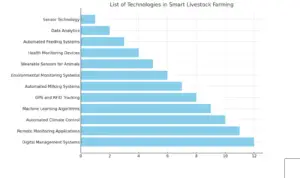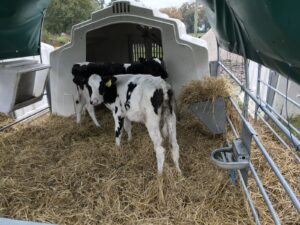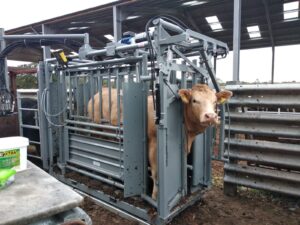Animal farming has a long history, stretching back to approximately 10,000 years ago when people began domesticating animals. These early farmers recognized the value of animals as sources of meat, milk, and hides.
Over the centuries, farming animals has become vital to our global food systems and economies. It plays a crucial role in sustaining livelihoods and ensuring food security worldwide.
However, in recent times, animal farming has also become a topic of intense discussion and examination. This scrutiny stems from various environmental, ethical, and public health.
Types of Animal Farming
The scale of fams can vary from small, family-run operations to large-scale commercial farms with thousands of animals.
Farming animals includes breeding, feeding, and generally looking after the welfare and health of the animals. Farmers aim to produce valuable products, including food like meat, milk, and eggs, and non-food products like wool, leather, and honey.
Animal welfare and good health are paramount for economically sustainable farm businesses. Farmers must provide feeding, bedding, general care, and medical attention from Veterinarians for vaccinations, disease prevention, and treatments for illnesses.
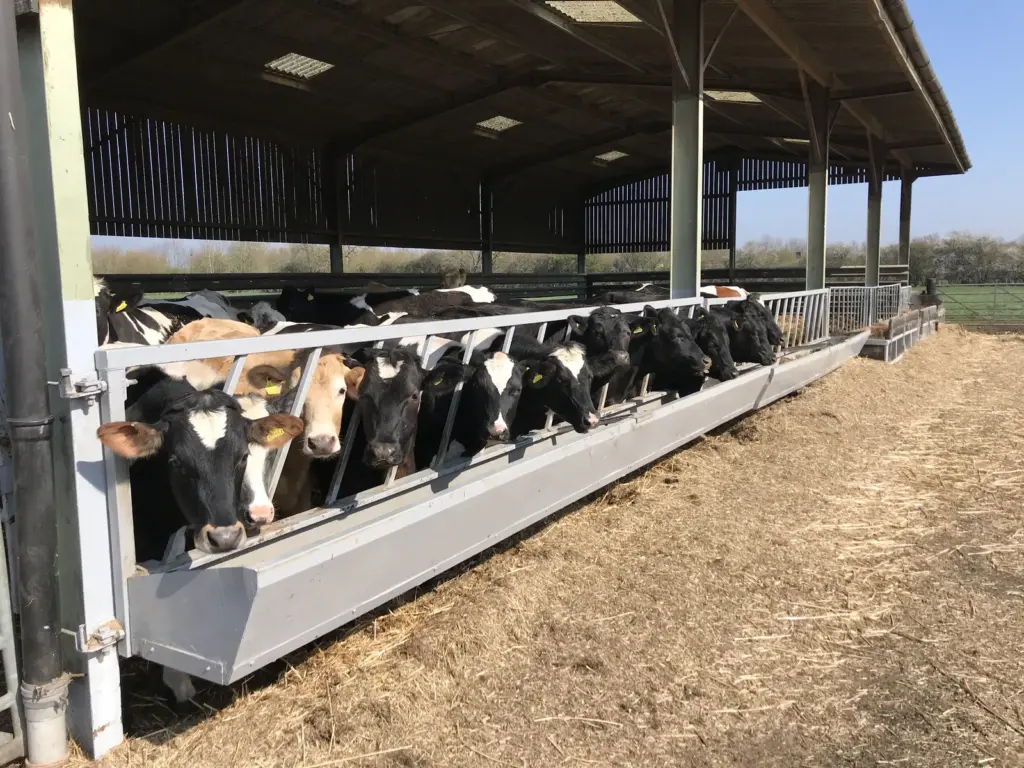
Livestock Farming
It typically involves keeping cows, sheep, pigs, goats, and horses. Livestock farming can be divided into dairy farming (producing milk), meat production, and fiber production (like wool or leather).
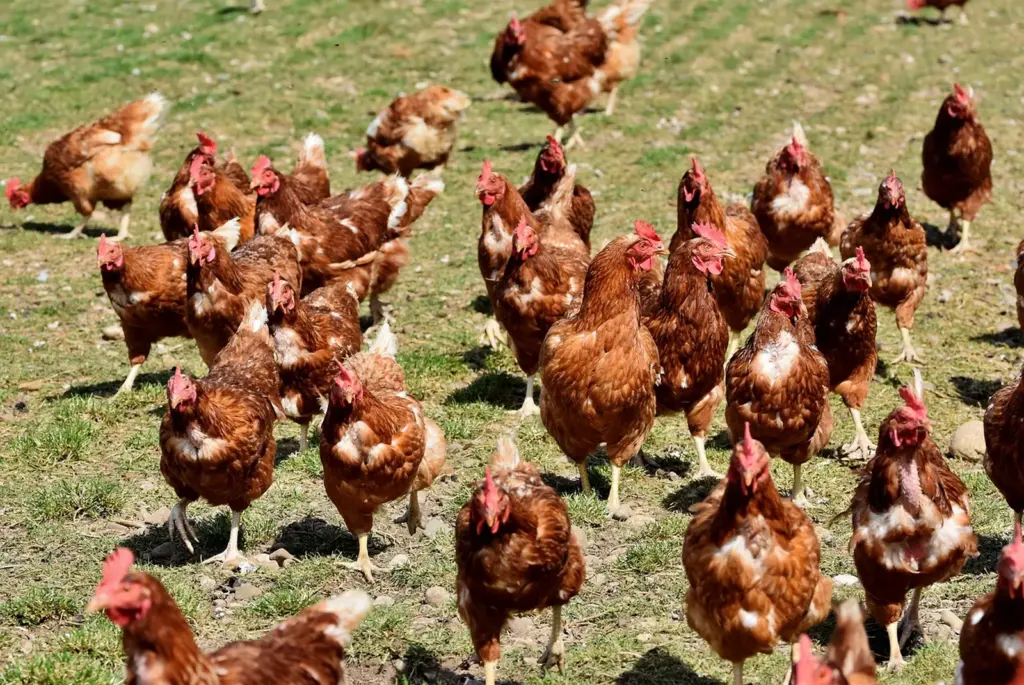
Poultry Farming
Commonly farmed poultry includes chickens, turkeys, ducks, and geese. Various subcategories within poultry farming include broiler production (for meat), layers for egg production, and breeding chickens
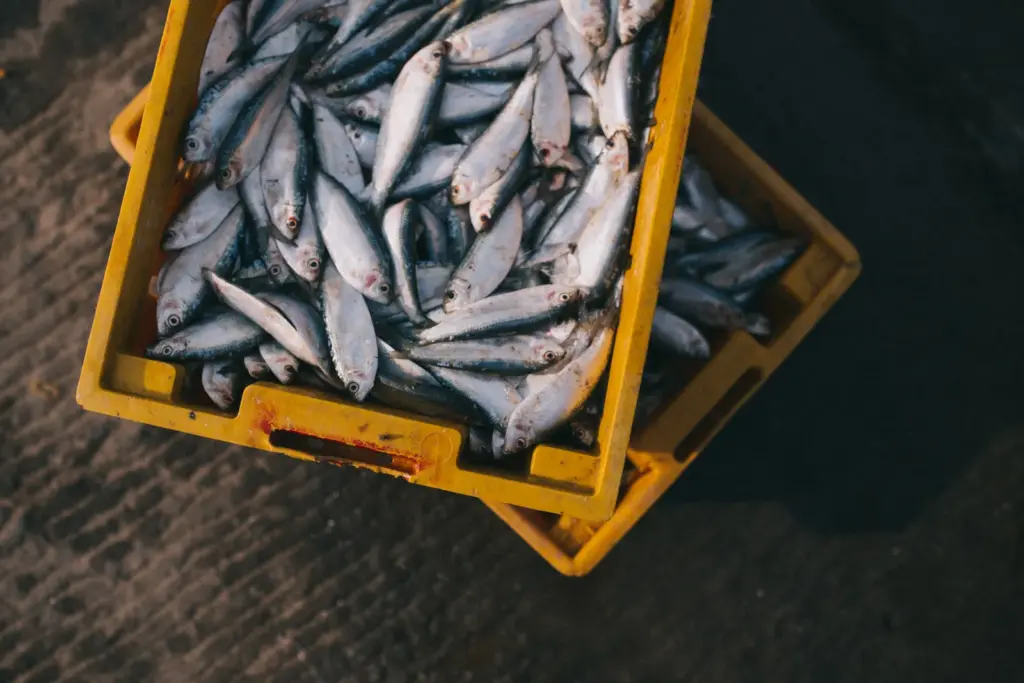
Aquaculture
Also known as fish farming, it involves breeding, rearing, and harvesting fish, shellfish, and aquatic plants in controlled water environments.
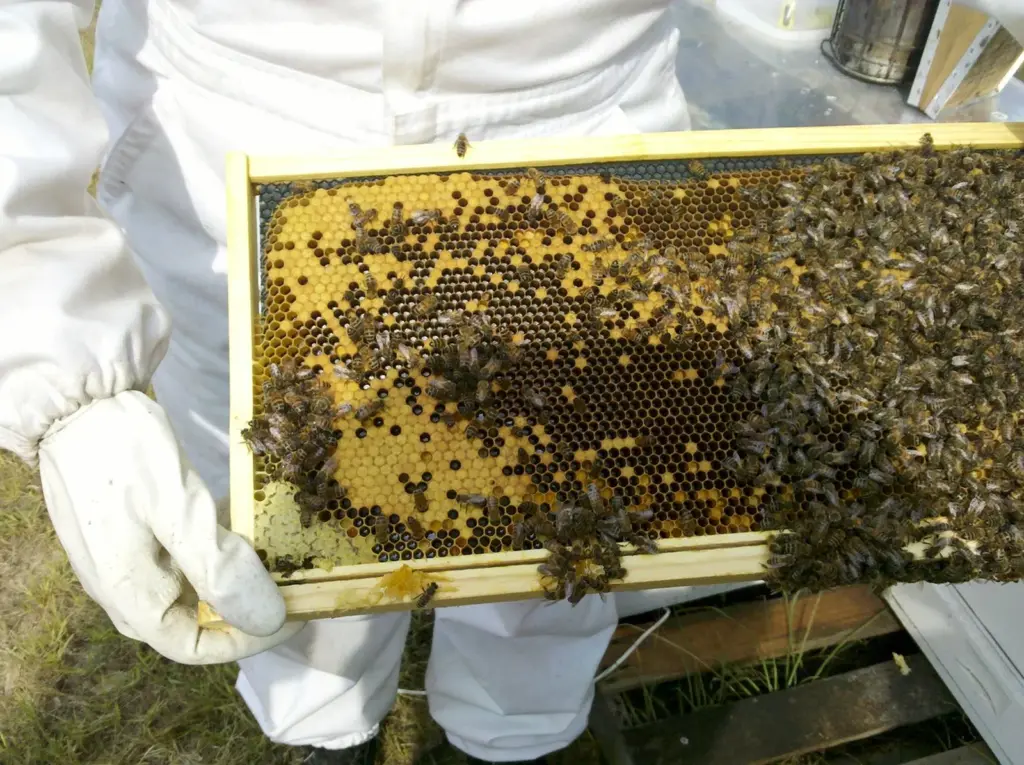
Apiary (Bee Farming)
Beekeeping is the practice of maintaining bee colonies, usually in hives, to produce honey and beeswax. Beekeepers also often provide pollination services to crop farmers and other services.
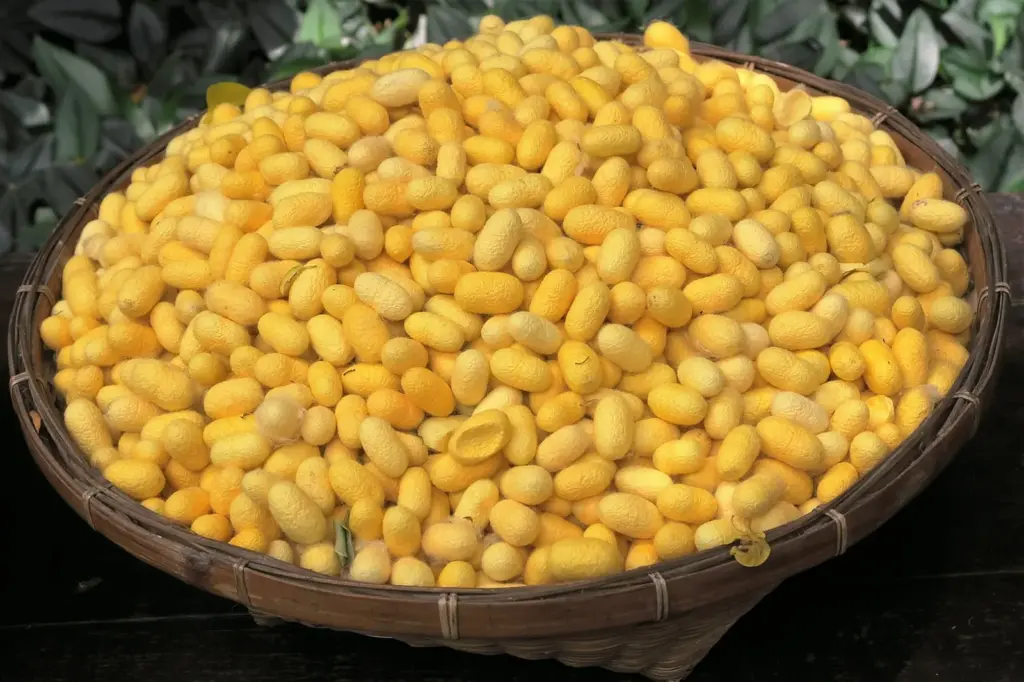
Sericulture (Silk Farming)
This involves rearing silkworms to produce silk, a valuable and widely used fiber.
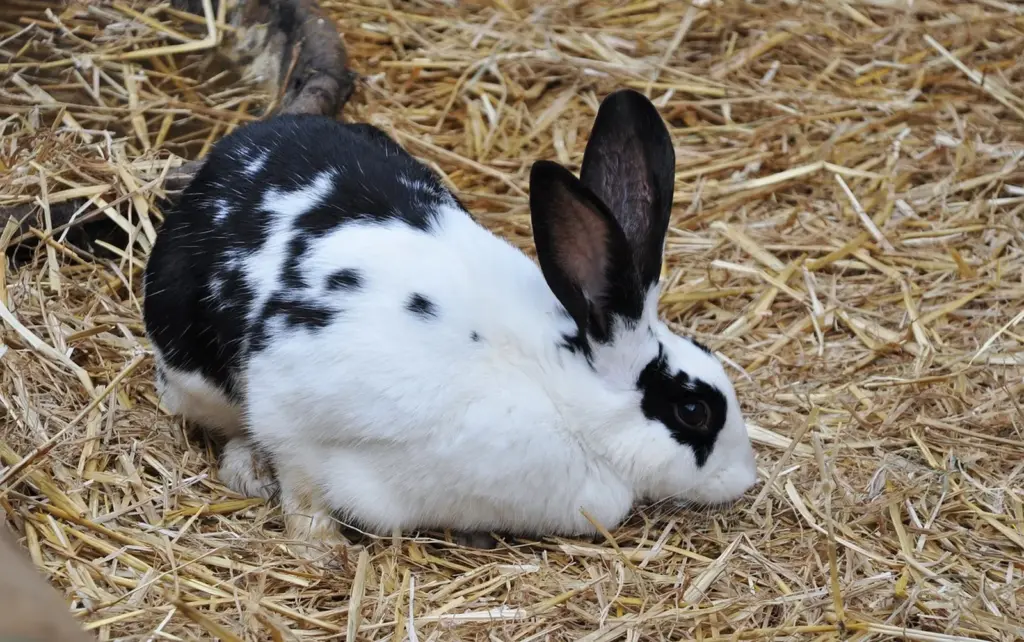
Rabbit Farming
Rearing rabbits for meat or wool production. This system is not widely practiced, but it is a form of farming still present in several countries, and it is the subject of debates due to sometimes poor welfare conditions and ethical issues.
Most Common Animals Farmed
- Cattle: Cattle are farmed for their meat (beef), dairy products, and hides.
- Poultry: Chickens are the most common type of poultry, farmed for their meat and eggs. Other types of poultry include turkeys, ducks, and geese.
- Pigs: Pigs are one of the most profitable types of livestock to farm due to their high meat yield and rapid growth rate. They are primarily raised for meat.
- Sheep: Sheep are farmed for several products, including meat (lamb and mutton), milk, and wool.
- Goats: Goats are farmed for meat, milk. Some goats, such as the Angora breed, are also farmed for their wool, known as mohair.
- Fish: Several fish species, such as salmon, trout, and catfish, are farmed on a large scale. This practice is also known as aquaculture.
- Shrimp: Shrimp farming, part of aquaculture, is another common practice, with species like the white-leg shrimp being widely farmed.
- Rabbits: Though less common than those listed here, rabbits are also farmed for meat and wool.
- Bees: Bees are farmed for honey, beeswax, pollen, and royal jelly. They also play a critical role in pollinating many of the plants that make up the world’s food supply.
- Buffaloes: In many parts of the world, especially Asia, buffaloes are farmed for their milk, meat, and hides.
Importance of Discussing Animal Farming Today
- Food Security: As the global population grows, so does the demand for food. Animal farming plays a critical role in providing protein-rich food sources.
- Economic Impact: Animal farming represents a significant portion of the global economy, providing livelihoods for millions of people. Many small-scale farmers and large agricultural enterprises rely on animal farming for economic sustainability.
- Environmental Considerations: Animal farming contributes to greenhouse gas emissions, deforestation, and water pollution. Sustainable farming practices can reduce this environmental impact while still meeting the demand for animal products.
- Animal Welfare: There’s a growing awareness and concern about the conditions in which farm animals are raised. Public awareness of good practice farming will play a crucial role in driving the industry to improve the lives of farmed animals.
- Public Health: Antibiotic resistance and the spread of zoonotic diseases (diseases that can be transmitted from animals to humans) are significant public health concerns often linked to animal farming. The COVID-19 pandemic has further emphasized the importance of improving animal health and disease control.
- Technological Advancements: New technologies and practices are continually being developed to improve animal farming. Discussions in this field can lead to the adoption of innovations that will enhance productivity, sustainability, and animal welfare.
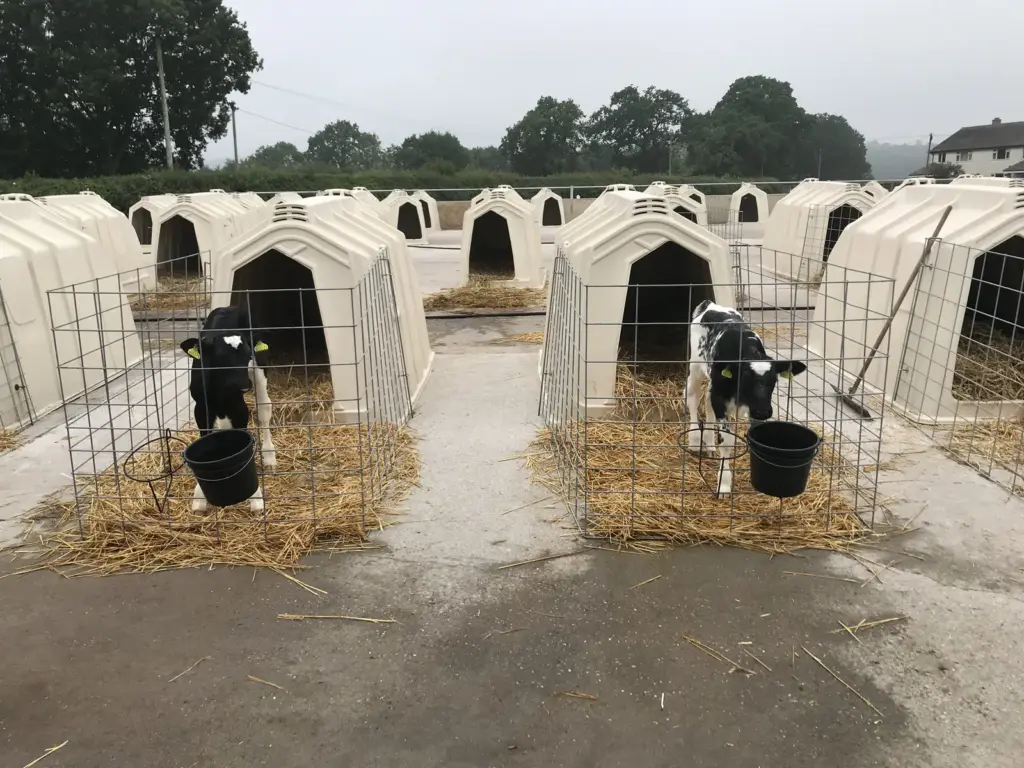
The Importance of Animal Welfare
Animal welfare is an important topic for ethical reasons and because it can significantly impact farm productivity and product quality. When animals are healthy and well-cared for, they are more likely to have better reproductive performance and produce higher-quality products.
Additionally, consumer awareness and concern about the welfare of animals raised for food are growing and can positively drive an improvement in farming practices, increasing the well-being of animals. This change in mindset can allow farms with higher welfare standards can gain a competitive advantage in the market.
Challenges of Animal Welfare
Despite its importance, achieving high animal welfare standards can be challenging.
- Economic Constraints: Implementing high welfare standards can involve significant costs, such as investments in better housing or more skilled labor. These costs can be prohibitive for many farmers, especially in low-income regions.
- Lack of Knowledge or Training: Many welfare problems arise from a lack of understanding of animals’ needs and how to meet them. Education and training are essential, but reaching all farmers and workers, especially in remote or less developed areas, can be problematic.
- The scale of Production: On large-scale farms, also known as factory farms, ensuring the welfare of each animal can be difficult, and economic drivers may jeopardize animal welfare.
- Legislation and Enforcement: While many countries have animal welfare laws, enforcement can be inconsistent. Many industries, especially in developed countries, have farming organizations and certification bodies with rules to ensure farming practices follow high welfare standards. It is the case of Red Tractors in the UK or Certified Animal Welfare Approved by AGW and certified grass fed by AGW in the US.
Addressing these challenges requires a holistic approach that includes research, education, policy-making, and market incentives to encourage improved welfare practices.
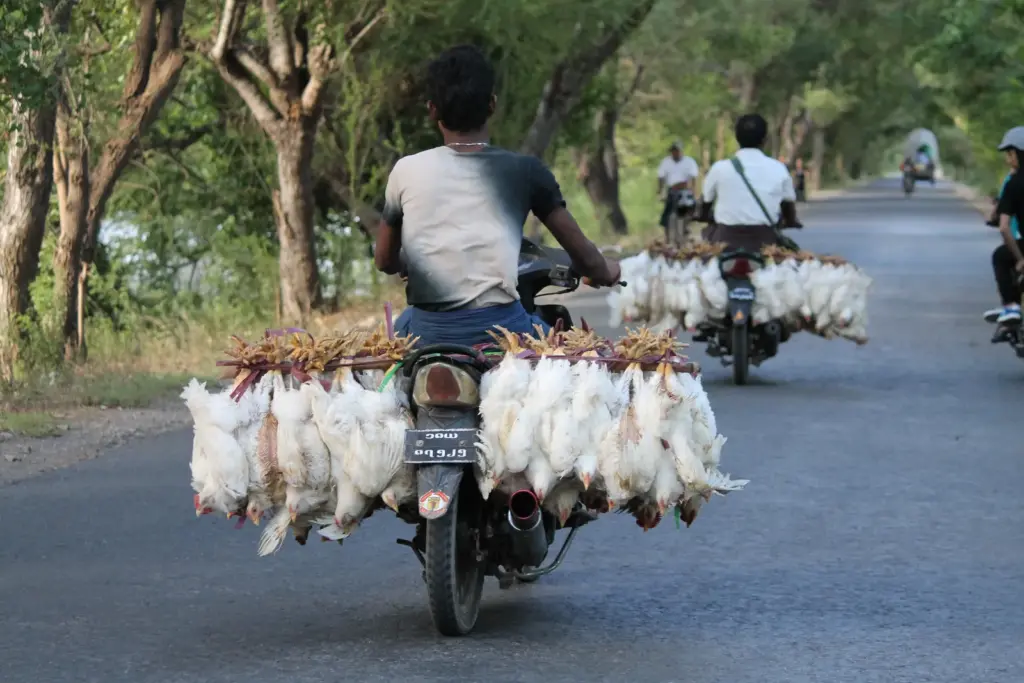
The Five Freedom of Animal Welfare
- Freedom from hunger or thirst: Always provide proper food and clean water.
- Freedom from discomfort: They should always have access to shelter and a comfortable resting area.
- Freedom from pain, injury, or disease: Regular health care, disease prevention, and proper medical treatment and relief from pain.
- Freedom to express normal behavior: Providing appropriate space, facilities, and social interaction according to the animal’s natural behaviors.
- Freedom from fear and distress: Providing the animals with the right conditions to avoid mental and physical suffering.
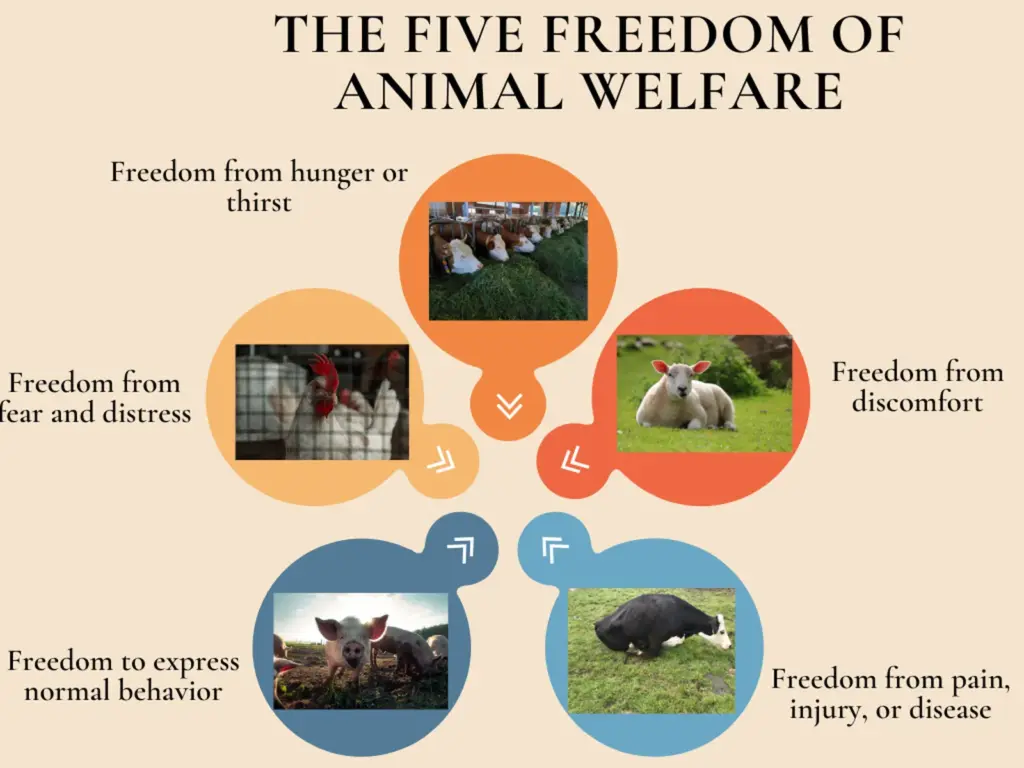
Best Husbandry Practices
When keeping livestock, deep knowledge of the animals’ physiological and social needs is essential. Providing food and shelter is vital, and creating the right environment for them to express their natural behaviors is critical for their psychological needs.
In 1965, the UK investigated the welfare of intensively farmed animals due to concerns stemming from Ruth Harrison’s book – Animal Machines. The resulting Brambell Report established animal welfare standards known as Brambell’s Five Freedoms. Following the report, advisory committees were formed to oversee livestock welfare standards.
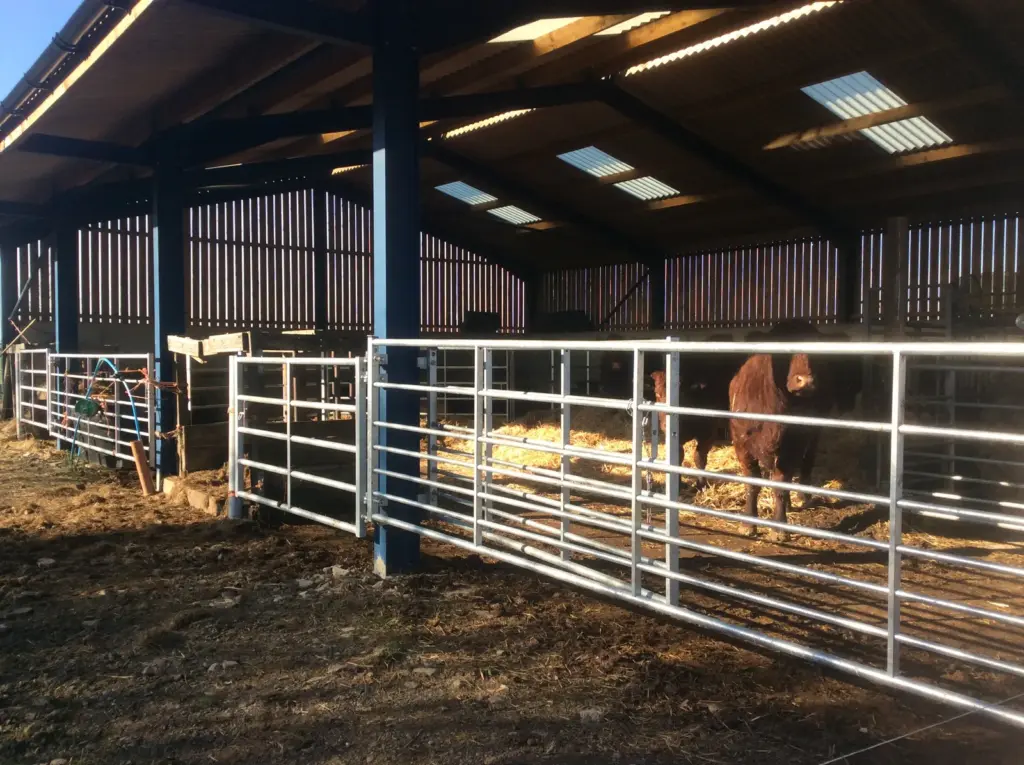
Principles of Animals Housing
Suitable housing is paramount for animal health, welfare, and productivity. Livestock accommodation should provide adequate space for each animal to express natural behaviors like lying down, standing, walking, and stretching. It should also protect animals from adverse weather conditions and predators. The accommodation should allow proper ventilation, maintain air quality, and control temperature and humidity. Poor ventilation can lead to respiratory diseases and heat stress.
Bedding and Cleanliness
Regularly cleaning accommodation areas and providing clean, dry bedding is crucial for preventing disease and maintaining animal comfort. Bedding materials can vary, but they should always be non-toxic, absorbent, and free from contaminants that could harm the animals. Regular removal of waste products prevents the build-up of harmful gases and bacteria, reducing the risk of disease transmission.
Principles of Animal Feeding
Whether animals are fed in-house or at pasture, diets should be balanced and appropriate for the animal’s age, breed, sex, health status, and production requirements.
For example, feeding a pregnant cow requires meticulous nutritional planning and diet composition compared to a non-pregnant cow.
Water Availability
Animals should have continuous access to clean, fresh water. Water intake is critical for various physiological processes, including digestion, nutrient absorption, waste excretion, and temperature regulation. Inadequate water supply, or poor quality water, can lead to dehydration, negatively affecting animal health and productivity.
The Problem of Factory Farming
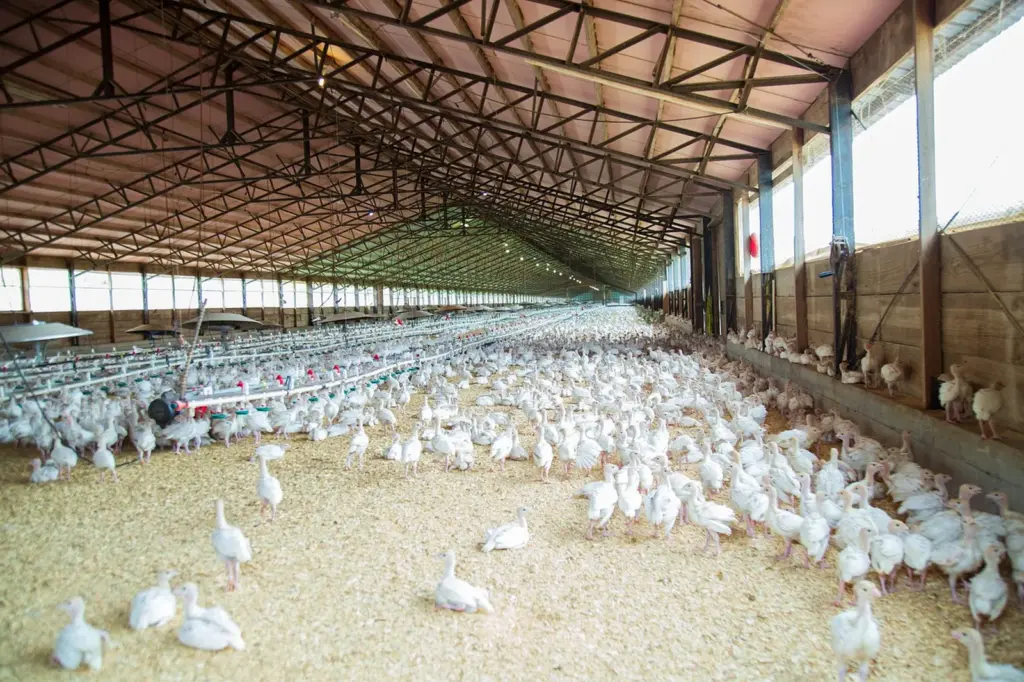
Factory farms approach to livestock keeping is to use intensive methods by which poultry, pigs, or cattle are confined indoors under strictly controlled conditions. This method is designed to maximize production at the lowest possible cost. However, this approach to farming presents numerous challenges concerning animal welfare:
- Confinement: In factory farming, animals are often kept in confined spaces, like battery cages or feedlots. These spaces are usually so small that animals cannot roam freely or exhibit natural behaviors. This lack of movement can lead to various physical and psychological health problems.
- Stress: The stressful conditions in factory farms, including high stock density levels, artificial lighting, and high energy diet, can lead to abnormal behaviors and increase susceptibility to diseases.
- Health Problems: The crowded conditions of factory farms can potentially facilitate the rapid spread of diseases. Resourcing to constant use of antibiotics can lead to antibiotic resistance. Furthermore, some animals are selectively bred for rapid growth, leading to physical issues such as bone and heart problems.
- Inadequate Veterinary Care: Due to the large number of animals, giving each one the necessary medical attention is challenging and expensive. Sick animals often don’t receive proper care and continue living in discomfort.
- Inhumane Practices: Control and managing large groups of animals in an automated system with low labor and resource input requires some husbandry practices like dehorning, tail docking, debeaking, and castration. Some of these practices can be avoided with simple management changes or a Veterinary professional’s help. Unfortunately, in factory farming, the goal of achieving high profit with low input can easily lead to performing these practices at a very low standard.
- Poor Nutrition: Animals are often fed a high-energy diet to maximize growth. These are often against the animal’s physiological needs and can lead to metabolic disorders.
Benefits of Animal Farming
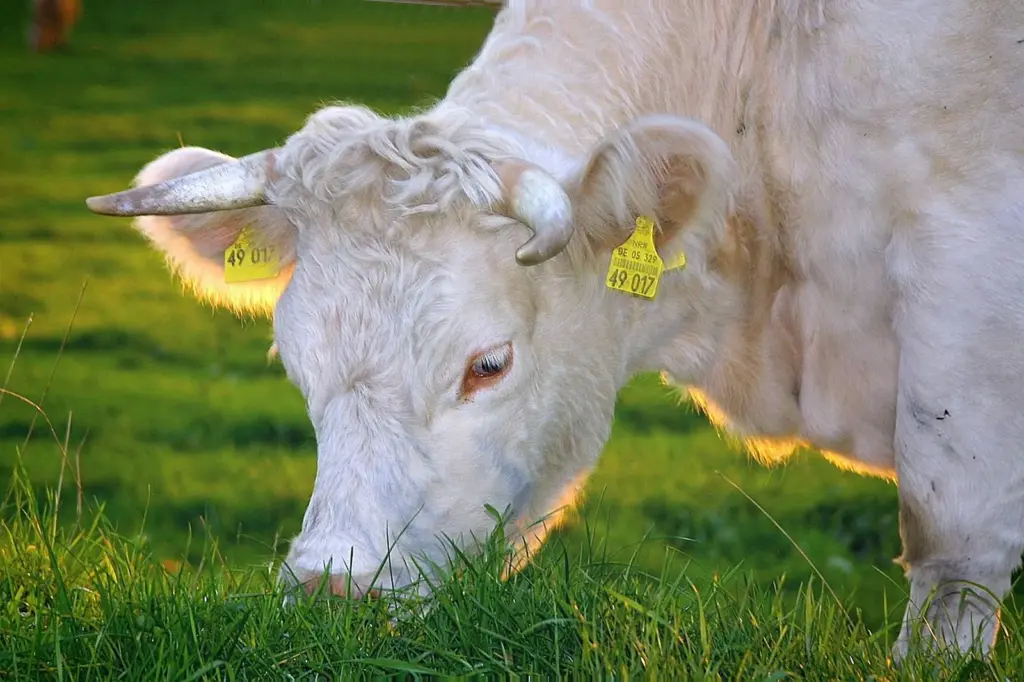
A. Contribution to the Economy
Animal farming plays a critical role in the global economy. It provides employment opportunities in rural areas, directly on farms and indirectly through associated industries like feed production, slaughtering, processing, and retail. According to the Food and Agriculture Organization, livestock farming alone accounts for approximately 40% of the global agricultural output.
B. Provision of Food Supply
Animal farming is vital to the global food supply. It provides a significant source of high-quality protein in the form of meat, milk, and eggs. In addition, animal farming can help secure food supply in areas with harsh climates or poor soil quality where crop cultivation is challenging or impossible.
C. Utilization of Animal By-Products
Beyond the main products like meat, milk, and eggs, animals produce many by-products used in various industries. For example, bones and hides manufacture products like gelatin and leather, manure can be used as a natural fertilizer, and certain animal fats produce biodiesel. These by-products add economic value to the animal farming industry and contribute to more efficient use of resources.
Challenges in Animal Farming
A. Environmental Impact of Animal Farming
- Greenhouse Gas Emissions: Livestock farming significantly contributes to greenhouse gas emissions, mainly methane and nitrous oxide, which have a much higher warming potential than carbon dioxide. Methane is primarily produced by enteric fermentation in ruminant animals like cows and sheep, while nitrous oxide is released from manure and urine. These emissions contribute to climate change.
- Land and Water Usage: Animal farming requires large land for grazing or growing feed. It’s estimated that around 26% of the planet’s ice-free land is used for livestock grazing, and 33% of croplands are used for feed production.
- Waste Management: Improper handling and disposal of manure can lead to water and soil pollution. Nutrients in the manure, like nitrogen and phosphorus, can leach into waterways causing eutrophication, which degrades water quality and can result in harmful algal blooms and dead zones. Moreover, manure can also contribute to air pollution, releasing gases such as ammonia and hydrogen sulfide.
Sustainable Animal Farming
Creating an animal farming system that prioritizes animal welfare and environmental sustainability is possible. A system that simultaneously supports farmers’ economic stability and contributes to the local community’s well-being.
Critical aspects of a sustainable animal farming system include:
- Animal Welfare: Sustainable farming practices respect animals’ natural behaviors and needs. Animals are often given access to outdoor spaces, are fed a natural and balanced diet, and are not subjected to unnecessary stress or harmful procedures. The health of the animals is closely monitored, and the use of antibiotics is strictly controlled.
- Environmental Stewardship: This system may include managing manure to minimize water pollution, optimizing grazing patterns to prevent land degradation and promote soil health, and reducing reliance on feed crops that require significant land and water use.
- Economic Viability: For a farming system to be sustainable, it must also be economically viable for the farmers. Economic sustainability can be achieved through efficient resource use, diversification of income sources, and tapping into markets for sustainably produced products.
- Community Involvement and Fair Labor: Sustainable animal farming often involves a commitment to the local community. Providing local employment, ensuring fair working conditions, contributing to regional food security, or participating in local decision-making are all critical aspects of a socially sustainable system.
- Resilient and Adaptable Systems: An essential characteristic of sustainable systems is their ability to withstand and recover from various shocks, whether they are economic (like market fluctuations), environmental (like droughts or disease outbreaks), or social (like changes in consumer preferences).
In essence, a sustainable animal farming system balances the needs of the animals, the environment, the farmers, and the broader community to produce food in a way that can be maintained over the long term. These systems may look different in different places, reflecting the local climate, culture, market conditions, and available resources.
Sustainable Husbandry Systems
1. Pasture-Based Systems
Pasture-based systems, also known as free-range or extensive farming, involve allowing animals to roam freely outdoors for a significant portion of their lives. These systems allow animals to express natural behaviors like grazing, rooting, or pecking. They can also offer environmental benefits such as:
- Soil Health: Grazing animals can help improve soil health and recycle nutrients through manure.
- Biodiversity: Pastures can support various plant and animal species, contributing to local biodiversity.
- Carbon Sequestration: Well-managed pastures can sequester soil carbon, helping mitigate climate change.
However, pasture-based systems require careful management to prevent overgrazing, soil degradation, and other environmental issues.
2. Agroforestry
Agroforestry involves integrating trees with crops or animals on the same land. In animal farming, this can be silvopasture (integrating trees with pasture and livestock) or forest farming (raising animals in a woodland ecosystem).
Benefits of agroforestry include:
- Diversified Income: By producing multiple products (e.g., meat, milk, eggs, timber, fruits, nuts) from the same piece of land, farmers can diversify their income and reduce financial risk.
- Environmental Protection: Trees can help protect soils from erosion, sequester carbon, and create habitats for wildlife. They can also provide shade and shelter for animals, improving their welfare when not housed.
- Resource Efficiency: Trees and crops can complement each other efficiently using resources. For example, animals can feed on fallen fruits or crop residues, while their manure provides nutrients for the trees and crops.
3. Mixed Farming Systems
Mixed farming systems involve combining crop cultivation with animal farming. For example, a farmer might raise livestock and grow feed crops on the same farm. This system has several benefits:
- Nutrient Cycling: Animals can feed on crop residues, and their manure can be used as a natural fertilizer, reducing waste and improving soil fertility.
- Risk Management: By diversifying their operations, farmers can spread their risks and become less dependent on a single crop or livestock species.
- Sustainability: By reducing reliance on external inputs (e.g., synthetic fertilizers, purchased feed), mixed farms can be more sustainable and resilient.
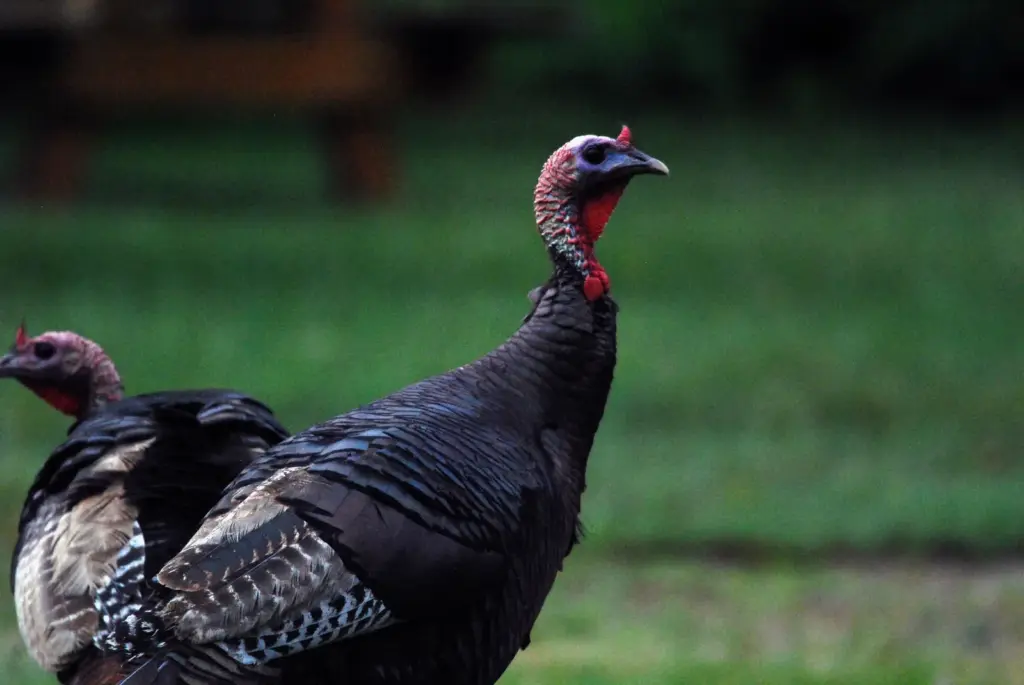
Innovations in Animal Farming
- Precision Farming: New technologies to monitor and optimize agricultural processes have recently been implemented. In animal farming, this can involve GPS tracking of grazing patterns, automated feeding systems that adjust rations based on an animal’s needs, and wearable technology to monitor animals’ health in real-time.
- Artificial Intelligence and Machine Learning: AI and machine learning can help analyze data collected on farms, assisting farmers to make more informed decisions about animal health, nutrition, and breeding.
- Genetic Engineering: Advances in genetic engineering have potential applications in animal farming, such as creating disease-resistant breeds or optimizing animals for specific environmental conditions.
- Vertical Farming: While more common in crop production, vertical farming techniques are also being explored in animal farming, particularly aquaculture.
Conclusions: Future of Animal Farming
Animal farming is an essential part of our planet and society. Several factors must be considered to improve animal welfare and health through proper husbandry practices.
The future of how we farm animals depends on our capacity to create awareness, understand the needs of animals, and consider social development and the health of our planet.
There is a growing emphasis on sustainability and regenerative practices as concerns about the environmental implications of conventional animal farming intensify. With advancements in precision farming, AI, and genetic engineering, technology will be paramount to enhance production and animal welfare and mitigate environmental impacts.
Moreover, as consumers become more aware of animal welfare, there is expected to be a surge in animal welfare standards encompassing enhanced living conditions, husbandry practices, and medical care.
Incentives provided by governments can steer the industry towards sustainable practices, such as offering subsidies to those who embrace regenerative methods, allocating funds for research, and supporting farmers transitioning to sustainable systems.
Transparent and enforceable food labeling policies can steer consumers towards animal products that are sustainably and ethically sourced, thus fostering demand for improved farming systems.
We value your thoughts on this critical topic. Please take a moment to comment on this article and share it with your network so that we can amplify the conversation surrounding the future of animal farming.

